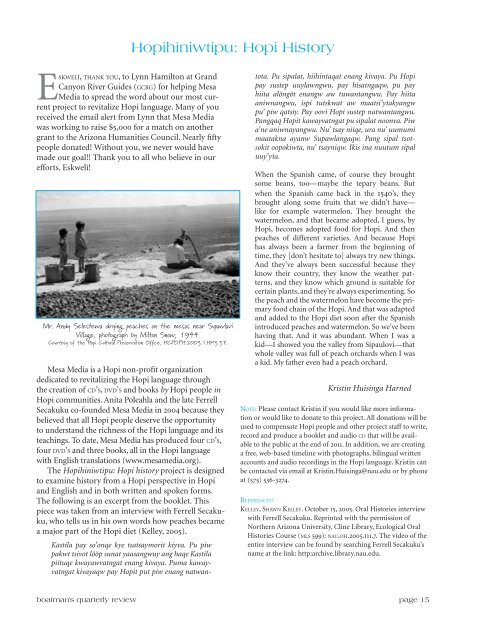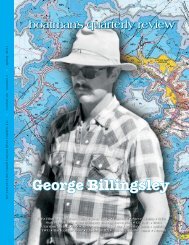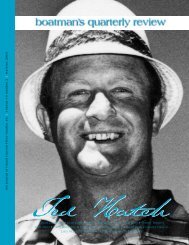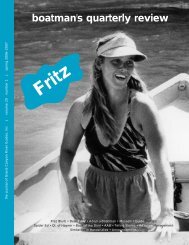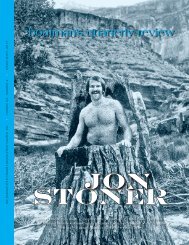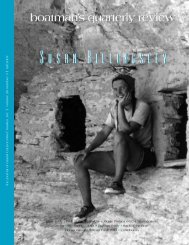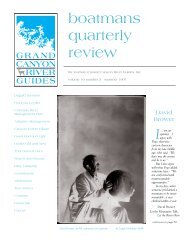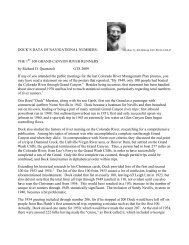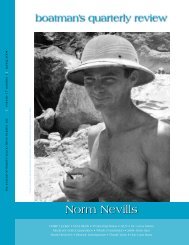fall 11 / 24:3 - Grand Canyon River Guides
fall 11 / 24:3 - Grand Canyon River Guides
fall 11 / 24:3 - Grand Canyon River Guides
- No tags were found...
Create successful ePaper yourself
Turn your PDF publications into a flip-book with our unique Google optimized e-Paper software.
Hopihiniwtipu: Hopi HistoryEskwelí, thank you, to Lynn Hamilton at <strong>Grand</strong><strong>Canyon</strong> <strong>River</strong> <strong>Guides</strong> (gcrg) for helping MesaMedia to spread the word about our most currentproject to revitalize Hopi language. Many of youreceived the email alert from Lynn that Mesa Mediawas working to raise $5,000 for a match on anothergrant to the Arizona Humanities Council. Nearly fiftypeople donated! Without you, we never would havemade our goal!! Thank you to all who believe in ourefforts. Eskwelí!Mr. Andy Selestewa drying peaches on the mesas near SupawlaviVillage, photograph by Milton Snow, 1944.Courtesy of the Hopi Cultural Preservation Office, HCPO.PH.2003.1.HH3.37.Mesa Media is a Hopi non-profit organizationdedicated to revitalizing the Hopi language throughthe creation of cd’s, dvd’s and books by Hopi people inHopi communities. Anita Poleahla and the late FerrellSecakuku co-founded Mesa Media in 2004 because theybelieved that all Hopi people deserve the opportunityto understand the richness of the Hopi language and itsteachings. To date, Mesa Media has produced four cd’s,four dvd’s and three books, all in the Hopi languagewith English translations (www.mesamedia.org).The Hopihiniwtipu: Hopi history project is designedto examine history from a Hopi perspective in Hopiand English and in both written and spoken forms.The following is an excerpt from the booklet. Thispiece was taken from an interview with Ferrell Secakuku,who tells us in his own words how peaches becamea major part of the Hopi diet (Kelley, 2005).Kastila pay so’onqe kye tsatsaymorit kiyva. Pu piwpakwt tsivot lööp sunat yaasangwuy ang haqe Kastilapiítuqe kwayawvatngat enang kivaya. Puma kawayvatngatkivayaqw pay Hopit put piw enang natwantota.Pu sipalat, hiihintaqat enang kivaya. Pu Hopipay sustep uuylawngwu, pay hisatngaqw, pu payhiita alöngöt enangw aw tuwantangwu. Pay hiitaaniwnangwu, ispi tutskwat aw maatsi’ytakyangwpu’ piw qatsiy. Pay oovi Hopi sustep natwantangwu.Pangqaq Hopit kawayvatngat pu sipalat noonva. Piwa’ne aniwnayangwu. Nu’ tsay niiqe, ura nu’ uumumimaatakna ayanw Supawlangaqw. Pang sipal tsotsokitoopokiwta, nu’ tsayniqw. Ikis ina nuutum sipaluuy’yta.When the Spanish came, of course they broughtsome beans, too—maybe the tepary beans. Butwhen the Spanish came back in the 1540’s, theybrought along some fruits that we didn’t have—like for example watermelon. They brought thewatermelon, and that became adopted, I guess, byHopi, becomes adopted food for Hopi. And thenpeaches of different varieties. And because Hopihas always been a farmer from the beginning oftime, they [don’t hesitate to] always try new things.And they’ve always been successful because theyknow their country, they know the weather patterns,and they know which ground is suitable forcertain plants, and they’re always experimenting. Sothe peach and the watermelon have become the primaryfood chain of the Hopi. And that was adaptedand added to the Hopi diet soon after the Spanishintroduced peaches and watermelon. So we’ve beenhaving that. And it was abundant. When I was akid—I showed you the valley from Sipaulovi—thatwhole valley was full of peach orchards when I wasa kid. My father even had a peach orchard.Kristin Huisinga HarnedNote: Please contact Kristin if you would like more informationor would like to donate to this project. All donations will beused to compensate Hopi people and other project staff to write,record and produce a booklet and audio cd that will be availableto the public at the end of 20<strong>11</strong>. In addition, we are creatinga free, web-based timeline with photographs, bilingual writtenaccounts and audio recordings in the Hopi language. Kristin canbe contacted via email at Kristin.Huisinga@nau.edu or by phoneat (575) 536-3274.References:Kelley, Shawn Kelley. October 15, 2005. Oral Histories interviewwith Ferrell Secakuku. Reprinted with the permission ofNorthern Arizona University, Cline Library, Ecological OralHistories Course (mls 599): nau.oh.2005.<strong>11</strong>1.7. The video of theentire interview can be found by searching Ferrell Secakuku’sname at the link: http:archive.library.nau.edu.boatman’s quarterly review page 15


